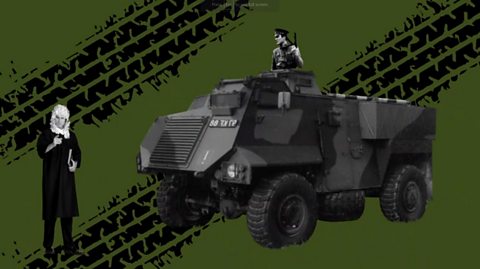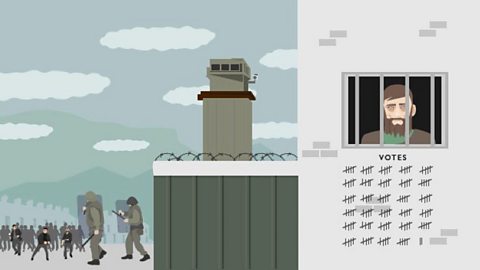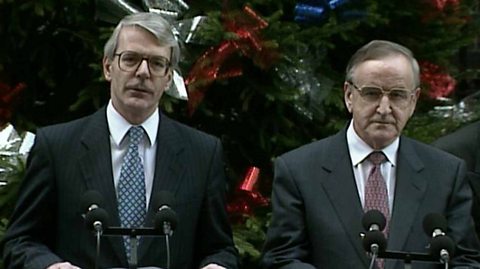A worsening situation
Rather than making things better, internmentImprisonment without trial. had made them much worse.
The events of Bloody SundayOn 30 January 1972, British soldiers from the Parachute Regiment shot 26 unarmed civilians following a protest march in the Bogside area of Derry, Northern Ireland in an event that became known as Bloody Sunday. 14 people were killed (13 died outright, one man died later of his injuries). indicated to the London government that Prime Minister Brian Faulkner and his cabinetThe name given to the core group of politicians who carry out the major roles within the ruling government of a country.were not really able to deal with the deteriorating security situation.
Faulkner responded to recent events by asking the British government for permission to:
- Bring back the B SpecialsFormerly part of the reserve police force in Northern Ireland. Disbanded in 1969.;
- Allow the Royal Ulster Constabulary (RUC)Police force in Northern Ireland from 1922 to 2001. to carry guns again.
The government in London refused to agree and instead asked the Northern Ireland Government to give up its power over law and order.
When Faulkner rejected this request, London decided to take control of things.
London takes control
In late March 1972, the British Government announced that it would:
- Take control of security in Northern Ireland.
- Appoint a member of the British Government to take care of the running of Northern Ireland.
- End internmentImprisonment without trial. gradually.
- Plan to hold a special vote (referendumWhen a question is decided by putting it to a public vote.) on whether or not there should be a border between Northern Ireland and the Republic of Ireland.
- Talk to local politicians to see if a government made up of members from all parties could be set up.
Losing control over security was too much for the Stormont Government and so all members decided to resign in protest.
The British Prime Minister, Edward Heath then announced that he was going to close the Northern Ireland Government and Parliament down (at first for one year although this was later extended) and start running Northern Ireland directly from London (known as Direct Rule).
Heath appointed William Whitelaw as Northern Irelandâs first Secretary of StateA politician who is in charge of a government department and who is usually a member of the Cabinet.
The end of Stormont: reactions
There were a number of responses to the closing down of the Northern Ireland Parliament:
- The Irish Government and the Social Democratic and Labour Party (SDLP)An Irish nationalist party in Northern Ireland. When it was set up in August 1970, the SDLP was moderately left wing on social and economic issues. At the same time, the party sought political reforms within Northern Ireland and the eventual re-unification of Ireland. were delighted. They saw the end of Stormont as providing the opportunity of a new start for Northern Ireland.
- While the Irish Republican Army (IRA)A republican paramilitary group which was determined to create an Irish Republic as proclaimed in the 1916 Easter Rising. welcomed the end of Stormont, it saw Direct Rule as evidence of even greater British involvement in the running of Northern Ireland and announced its determination to continue its struggle to achieve a united Ireland.
- unionistA person who believes the union between Britain and Northern Ireland should continue. leaders were outraged at the closing down of âtheirâ Parliament. Massive protests were organised by Ulster Vanguard, but London continued with its plans. There was also an increase in support for loyalistA person who, in terms of culture, identity and politics, retains a strong loyalty to Britain and firmly opposes a united Ireland. paramilitaryA person or organisation that operates like a military force, but is not part of a country's official armed forces. and a spate of sectarianBelonging to a religious or political group and being intolerant of those with different opinions. If you're a religious sectarian, you are loyal to a particular religious sect or group. killings. Meanwhile, support for the Democratic Unionist Party (DUP)A conservative and unionist party in Northern Ireland, formed in 1971 by the Rev Ian Paisley. The party has strongly opposed any role for the Republic of Ireland in the governing of Northern Ireland. From 1971-1998, it opposed the 1973-1974 Power Sharing Assembly and Executive, the Anglo-Irish Agreement and the Good Friday Agreement. and other strongly unionist parties also increased.
- The Northern Ireland Civil rights Association stated that its campaign for civil rights Rights everyone is entitled to regardless of the colour of their skin, their beliefs, sexuality, sex or other personal characteristics. These rights could include - amongst other things - the right to vote, the right to free speech or the right to a good education.would continue.
1972: The worst year of violence
If the London Government hoped to make things better by closing Stormont down, it was to be disappointed.
There were more violent deaths in 1972 than there were during any other year of âthe Troublesâ.
Nearly 500 people died in 1972.
As well as Bloody SundayOn 30 January 1972, British soldiers from the Parachute Regiment shot 26 unarmed civilians following a protest march in the Bogside area of Derry, Northern Ireland in an event that became known as Bloody Sunday. 14 people were killed (13 died outright, one man died later of his injuries). and an increasing amount of murders and bombings carried out by loyalistA person who, in terms of culture, identity and politics, retains a strong loyalty to Britain and firmly opposes a united Ireland. paramilitaryA person or organisation that operates like a military force, but is not part of a country's official armed forces. groups such as the Ulster Volunteer Force (UVF)A loyalist paramilitary organisation which could trace its origins back to 1912 and the fight against ±«Óătv Rule in Ireland â it later re-emerged in 1966 and was active throughout the Northern Ireland 'Troubles'. and the Ulster Defence Association (UDA)Formed in September 1971, it was active during the Northern Ireland 'Troubles' as a loyalist paramilitary group. It would often carry out attacks using the cover name Ulster Freedom Fighters (UFF).(claimed under the UFF name ), these deaths included:
- Nine people on 21st July 1972 as a result of Provisional Irish Republican Army (PIRA)Irish republican paramilitary group formed when members split from the Official IRA (OIRA) in 1969. bombs in Belfast This day became known as âBloody Fridayâ.
- Nine people on 31st July when PIRA bombs exploded in the village of Claudy, Co. Derry/Londonderry.
For more information, including archive clips, on this subject, visit ±«Óătv: Ten Chapters of the Northern Ireland Troubles ()
WATCH: Direct Rule in Northern Ireland
Test your knowledge
More on Changing relations: Northern Ireland and its neighbours, 1965-98
Find out more by working through a topic
- count7 of 11

- count8 of 11

- count9 of 11

- count10 of 11
